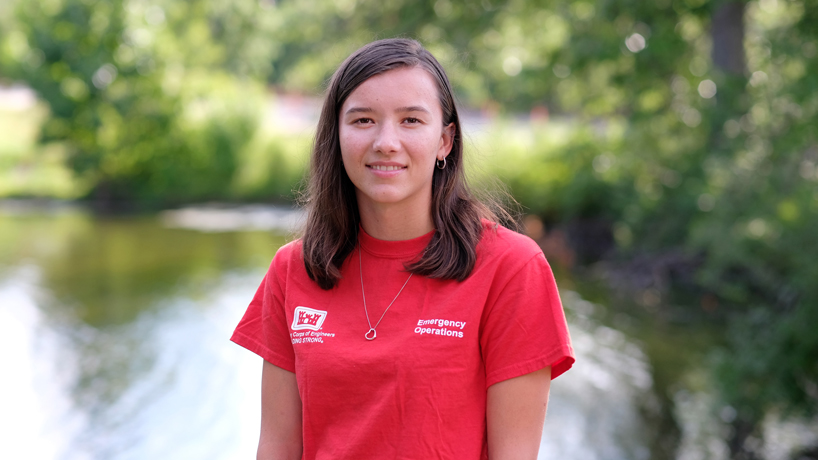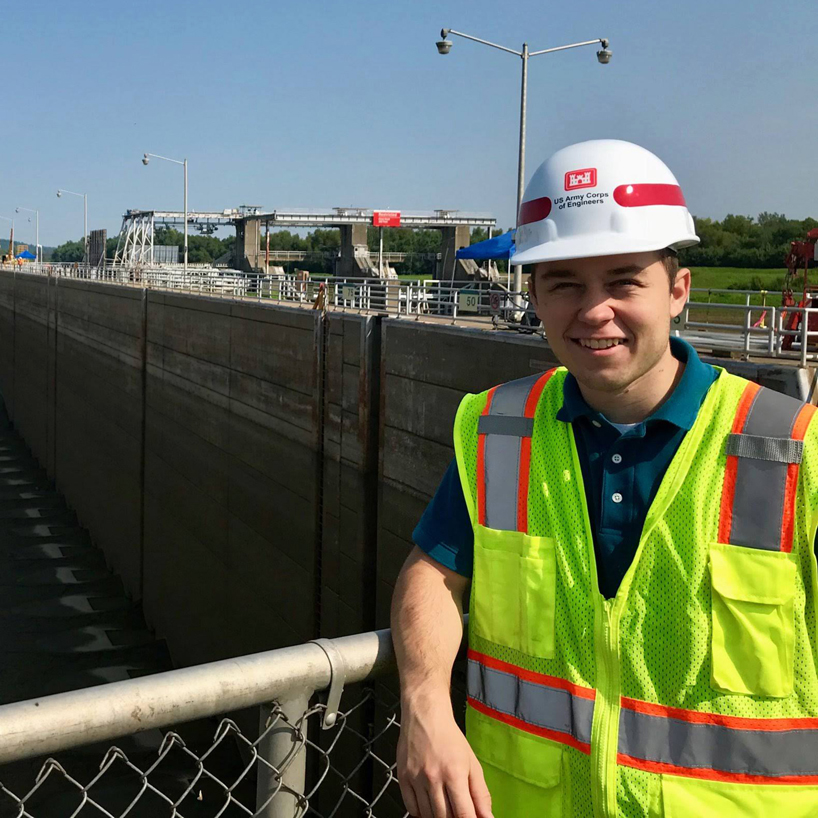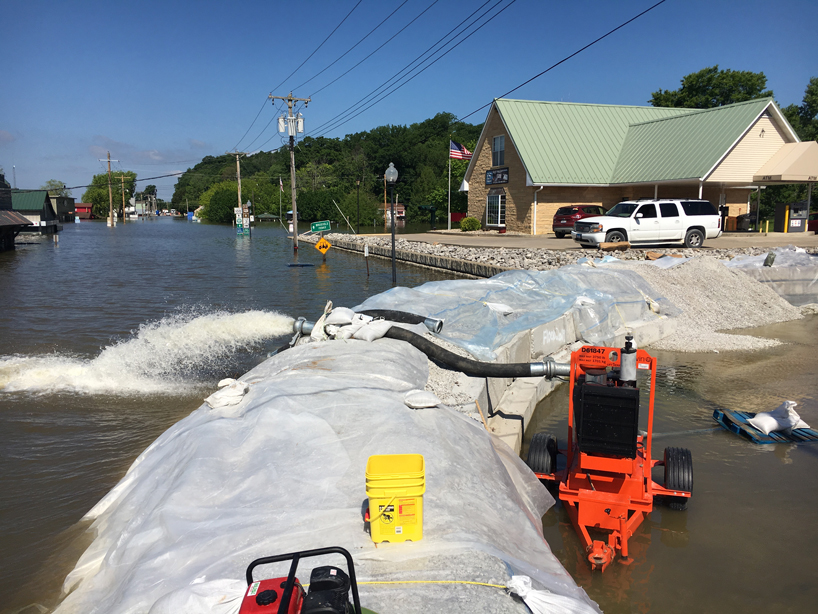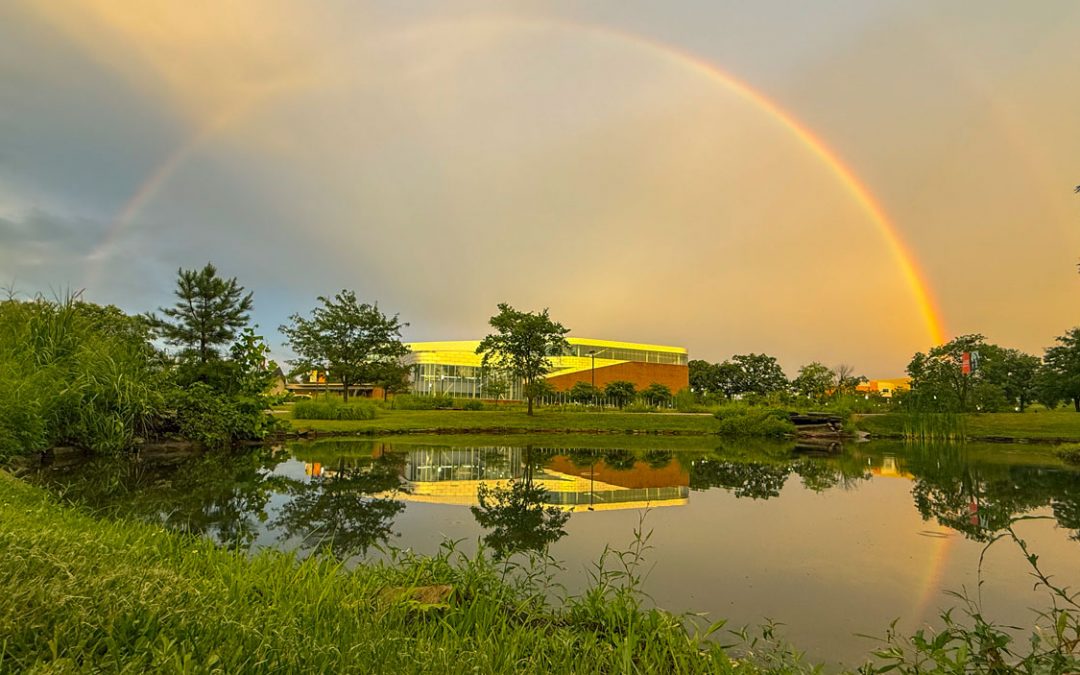
Kelly Sextro is one of several UMSL engineering students who have been helping fight near-historic flooding this summer with the U.S. Army Corps of Engineers. As a geotechnical student intern, she’s been busy helping maintain levees due to the high water levels. (Photo by August Jennewein)
There’s a space about the size of a quarter between Kelly Sextro’s hands, which she’s holding up to demonstrate the size of a potential sand boil.
That’s the telltale sign of a hole in a levee.
“Water is going to get through levees no matter what,” the University of Missouri–St. Louis civil engineering student explained. “You can’t hold back water completely. It’s going to find a way.”
Small sand boils, which look like little volcanos of water, are everywhere and not a cause for concern. It’s the big ones that she is searching for this summer.
Sextro, along with classmate Joshua Walker, is one of several UMSL/WUSTL Joint Undergraduate Engineering Program students who are aiding communities in the St. Louis district by fighting the region’s near-historic flooding with the U.S. Army Corps of Engineers.
Joshua Walker’s work with the U.S. Army Corps of Engineers could take him about 100 miles in any direction from downtown St. Louis. (Submitted photo)
The district, Walker explains, has two major focuses. The first is protecting water from people – safeguarding the environment, regulating who can build structures like levees and ensuring that people are being good stewards of water.
The second focus is protecting people from water. That’s the variety of work he and Sextro are doing – building and maintaining levees, dams and flood walls and advising communities on flood fighting techniques.
As an electrical engineering intern, Walker helps design and maintain the electromechanical systems of locks and dams, pumping stations and other federal projects. Much of the work he does is preventative: In advance of flooding, he will work with teams of mechanical, electrical, structural and civil engineers to visit the Corps’ sites to look for and resolve potential problems.
The St. Louis district that Walker’s division manages spans an area of roughly 100 miles from downtown in any direction, so he’s seen the scale and impact of the Corps’ activities firsthand.
“During different flooding operations, being able to go out and just look at the effect that our work has on communities and how our projects are directly impacting those people is really eye-opening,” Walker said. “It gives me a sense of pride and a feeling like I’m able to help people quite directly. It can be a very fulfilling, rewarding experience.”
Though Sextro’s role as a geotechnical student intern is, like Walker’s, with dams, she’s also been helping maintain levees because of the high water levels. Sextro and a technician drive along the levees taking measurements, such as water pressures, which are put into graphs with historic data to be analyzed later by an engineer.
The team is looking for inconsistent pressure readings and change over time. Warning indicators tend to be subtle: Sudden spikes usually mean bad readings or failing instruments, which then must be replaced.
The other part of her job is searching for the sand boils, which are challenging to spot. The worrisome ones are those that bring up sand and debris along with water.
“That means the inside of the levee is breaking down and eroding underneath,” she said. “If we don’t control it, it can carry material through the levee. That’s how breaches can happen.”
In June, water was pumped from a protected area near Grafton, Illinois, back into the river. Temporary barriers are often not watertight, so pumping is common to keep the protected areas as dry as possible. (Photo courtesy of the U.S. Army Corps of Engineers)
Sextro and others mark the sand boils with flagging and advise the levee owners on next steps. That usually means placing sandbags around them to create pressure and, for especially large ones, utilizing massive steel drums to contain the holes.
A misconception that many have, Sextro said, is that the Corps owns all the levees, which it doesn’t. In the St. Louis region, the only federally owned levee is Chain of Rocks East Levee on the Chain of Rocks Canal. Instead, the Corps advises the private owners – often farmers – on what steps to take. The experience of driving the levees has opened Sextro’s eyes to the risks inherent in farming.
“Their fields are flooded,” she said. “They can’t plant any crops. Some peoples’ property is just sitting in a few feet of water, being damaged, so I think it’s a concern for farmers most of all. Their livelihoods depend on the weather.”
Having seen how engineering impacts the quality of lives directly, both Sextro and Walker are thinking ahead to how they might change the world for the better. For Sextro, who has a large interest in sustainability, that might mean transportation design of low emissions communities.
Walker hopes to use engineering to solve challenging problems faced by industries and communities. That’s what drew him to the field in the first place.
“As long as I’m working somewhere I’m able to help people,” he said, “creating things that are new, that are changing the way we do things in this world for the better or making processes faster and more efficient, I’ll be quite happy.”
















